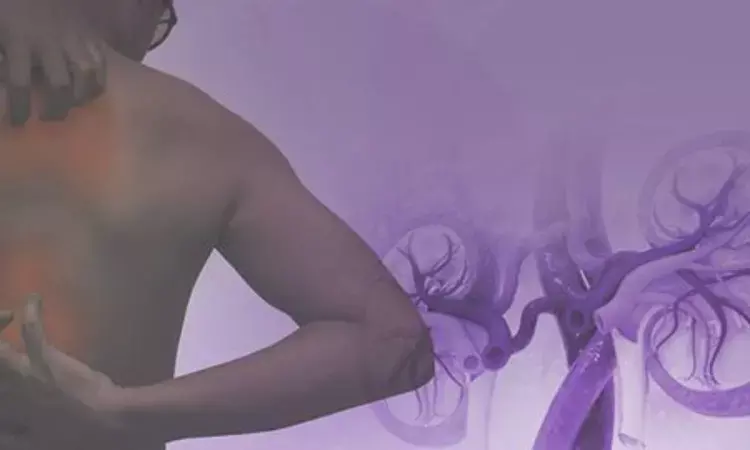- Home
- Medical news & Guidelines
- Anesthesiology
- Cardiology and CTVS
- Critical Care
- Dentistry
- Dermatology
- Diabetes and Endocrinology
- ENT
- Gastroenterology
- Medicine
- Nephrology
- Neurology
- Obstretics-Gynaecology
- Oncology
- Ophthalmology
- Orthopaedics
- Pediatrics-Neonatology
- Psychiatry
- Pulmonology
- Radiology
- Surgery
- Urology
- Laboratory Medicine
- Diet
- Nursing
- Paramedical
- Physiotherapy
- Health news
- Fact Check
- Bone Health Fact Check
- Brain Health Fact Check
- Cancer Related Fact Check
- Child Care Fact Check
- Dental and oral health fact check
- Diabetes and metabolic health fact check
- Diet and Nutrition Fact Check
- Eye and ENT Care Fact Check
- Fitness fact check
- Gut health fact check
- Heart health fact check
- Kidney health fact check
- Medical education fact check
- Men's health fact check
- Respiratory fact check
- Skin and hair care fact check
- Vaccine and Immunization fact check
- Women's health fact check
- AYUSH
- State News
- Andaman and Nicobar Islands
- Andhra Pradesh
- Arunachal Pradesh
- Assam
- Bihar
- Chandigarh
- Chattisgarh
- Dadra and Nagar Haveli
- Daman and Diu
- Delhi
- Goa
- Gujarat
- Haryana
- Himachal Pradesh
- Jammu & Kashmir
- Jharkhand
- Karnataka
- Kerala
- Ladakh
- Lakshadweep
- Madhya Pradesh
- Maharashtra
- Manipur
- Meghalaya
- Mizoram
- Nagaland
- Odisha
- Puducherry
- Punjab
- Rajasthan
- Sikkim
- Tamil Nadu
- Telangana
- Tripura
- Uttar Pradesh
- Uttrakhand
- West Bengal
- Medical Education
- Industry
Management of CKD associated pruritus- Current treatment options and future approaches

USA: A recent study, published in the Clinical Kidney Journal, reports new guidelines for the clinical management of patients with chronic kidney disease-associated pruritus (CKD-aP).
Chronic kidney disease-associated pruritus is an underdiagnosed yet severely distressing condition that affects 60% of patients on dialysis and many nondialysis patients with Stages 3–5 CKD. Despite its high prevalence not many treatment options are available for these patients and also there is a lack of treatment guidelines for clinicians.
Considering the above, Michael J Germain, Baystate Medical Center U Mass Medical School, Springfield, MA, USA, and colleagues evaluated the current management and treatment options for CKD-aP, including dialysis management, topical treatments, gabapentinoids, opioids, and alternative medicine by reviewing the available literature.
Based on the currently available evidence, the researcher's team proposed the following treatment recommendations in order to better manage these patients:
- All patients with CKD-aP should be dialyzed optimally according to Kt/V targets. If pruritus persists, a trial of an increased dialysis dose with a new Kt/V target of 1.5–1.7 for 1–2 months may be considered. This can be accomplished with increasing dialysis time and/or frequency. Converting to peritoneal dialysis can be considered.
- Comorbid medical conditions, both independent and associated with CKD (e.g. hyperparathyroidism), should be controlled.
- High water content emollients should be recommended for all patients. The addition of pramoxine to an emollient regiment may be recommended for extra relief.
- Topical therapies should be first-line in mild and/or localized CKD-aP.
- In generalized, moderate-to-severe, and/or refractory CKD-aP, systemic therapies should be pursued. Until now, gabapentinoids (gabapentin and pregabalin) had the most evidence supporting their safety and efficacy in these patients, and have therefore been considered first-line, with caution required regarding dosing (see above section: Gabapentinoids).
- With the recent FDA approval, the selective KOR agonists difelikefalin may be considered a safe and effective alternative to gabapentinoids. Physicians should follow the progress of new drugs like this closely.
- Alternative and adjuvant treatments, such as fatty acid supplementation, phototherapy, activated charcoal, cannabinoids, and acupuncture/acupressure should be considered on a patient-by-patient basis according to accessibility, practicality, financial status, and other comorbidities.
"In order to successfully tackle this pressing, debilitating and understudied condition there is a need for more research investigating the pathophysiology of CKD-aP, comparing the different available and in-development treatments with one another, and analyzing patient outcomes," wrote the authors.
"We encourage those able to design larger-scale, well-controlled studies to further advance our understanding of CKD-aP, and are optimistic about future advancements in this field," they concluded.
Reference:
Zoe M Lipman, Vijayakumar Paramasivam, Gil Yosipovitch, Michael J Germain, Clinical management of chronic kidney disease-associated pruritus: current treatment options and future approaches, Clinical Kidney Journal, Volume 14, Issue Supplement_3, December 2021, Pages i16–i22, https://doi.org/10.1093/ckj/sfab167
Dr Kamal Kant Kohli-MBBS, DTCD- a chest specialist with more than 30 years of practice and a flair for writing clinical articles, Dr Kamal Kant Kohli joined Medical Dialogues as a Chief Editor of Medical News. Besides writing articles, as an editor, he proofreads and verifies all the medical content published on Medical Dialogues including those coming from journals, studies,medical conferences,guidelines etc. Email: drkohli@medicaldialogues.in. Contact no. 011-43720751


